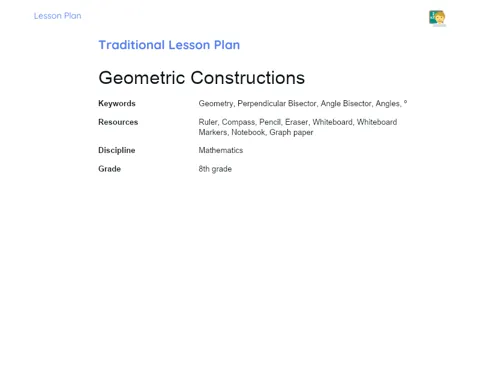Objectives (5 - 7 minutes)
Main Objectives:
- Understand the concept of factoring and its importance in solving mathematical problems.
- Master the factoring technique for difference of squares.
- Apply the factoring technique for difference of squares to simplify algebraic expressions and solve equations.
Secondary Objectives:
- Develop critical and logical thinking skills, necessary for solving complex problems.
- Improve communication and teamwork skills through discussions and group activities.
- Stimulate students' interest and motivation for Math by showing its applicability in everyday life.
By the end of the class, students should be able to:
- Explain what factoring is and why it is important in Math.
- Identify situations where factoring by difference of squares can be applied.
- Perform factoring by difference of squares of algebraic expressions.
- Solve equations using the factoring technique for difference of squares.
Introduction (10 - 15 minutes)
-
Reviewing Previous Content:
- The teacher should begin the class by reminding students about the concept of factoring, since it is the basis for understanding the current topic.
- It is also important to reinforce the technique for factoring quadratic expressions and solving quadratic equations, which were covered in previous classes.
- The teacher can do this through a short quiz or classroom discussion, to assess students' prior knowledge and identify possible gaps that need to be filled.
-
Contextualizing the Subject:
- The teacher should explain to students that factoring by difference of squares is an important and useful technique in Math, with applications in various areas, such as solving physics problems, simplifying expressions, and solving equations.
- The teacher can give practical examples of how factoring by difference of squares can be applied, such as in solving problems of area and volume, simplifying complex algebraic expressions, and solving second degree equations.
-
Problem Situations:
- The teacher may present students with two problem situations to awaken their interest and curiosity about the topic. For example:
- "How can we simplify the algebraic expression x^2 - 9? And if the expression were x^2 - 16?"
- "How can we solve the equation x^2 - 25 = 0? And if the equation were x^2 - 36 = 0?"
- The teacher should encourage students to think about these questions, without necessarily solving them at the moment. The goal is to have students realize the importance and relevance of the topic that will be covered in class.
- The teacher may present students with two problem situations to awaken their interest and curiosity about the topic. For example:
-
Capturing Students' Attention:
- The teacher can introduce the topic of the class by telling a curiosity or story related to factoring by difference of squares. For example, they could mention that this technique was developed by Islamic mathematicians in the 9th century and has been used ever since in various fields of science and engineering.
- Another strategy to capture students' attention is to show them how factoring by difference of squares can be used to solve everyday problems. For example, the teacher could explain how this technique can be applied to simplify the formula for the square of the sum or to solve problems involving areas of squares.
Development (20 - 25 minutes)
-
"Factoring in Practice" Activity:
- For this activity, the teacher will divide the class into groups of at most 5 students. Each group will receive a sheet of paper and a set of squares of different sizes. Students will be instructed to create quadratic expressions using the squares, such as: x^2 + 5x + 6.
- Next, students should factor the expressions created using the factoring technique for difference of squares. They should realize that not all of the expressions created can be factored in this way. This activity aims to help students visualize factoring by difference of squares in a more concrete and playful way.
- The teacher should circulate around the room, helping groups that encounter difficulties and checking if they are correctly applying the factoring technique for difference of squares. After completing the activity, each group should present an expression and its factoring to the class.
-
"Math Treasure Hunt" Activity:
- In this activity, the teacher will spread around the classroom cards with algebraic expressions that can be factored by difference of squares. Each card will have part of the answer to a math problem.
- Students, in their groups, must find the cards and solve the math problems. The teacher should give a time limit for the activity and offer clues, if necessary.
- The goal of this activity is to have students practice factoring by difference of squares in a fun and challenging way. In addition, they will have the opportunity to work in teams, discuss solutions, and learn from one another.
-
"Factoring Quiz" Activity:
- In this activity, the teacher will administer a quick quiz to check students' understanding of factoring by difference of squares. The quiz may contain multiple choice, true or false, fill in the blank, and other questions.
- The teacher should correct the quiz immediately after it is administered, explaining the correct answers and clarifying students' doubts. This activity aims to reinforce the content of the class and prepare students for the next lesson.
- The teacher should emphasize that the purpose of the quiz is not to evaluate students' performance, but to help them consolidate their learning. Therefore, the quiz should not be scored and students should not worry about getting all the answers right.
Review (10 - 15 minutes)
-
Group Discussion:
- The teacher should gather all students and lead a group discussion about the solutions found by each team in the "Factoring in Practice" and "Math Treasure Hunt" activities.
- During the discussion, the teacher should highlight the strategies used by students to solve the problems, the difficulties encountered, and possible alternative solutions.
- The teacher should encourage students to share their opinions, express their ideas, and question the solutions proposed by their peers.
- The goal of this discussion is to promote sharing of experiences and collaborative learning, in addition to allowing the teacher to make pedagogical interventions to clarify doubts and correct errors.
-
Connection with Theory:
- The teacher should review the theory presented at the beginning of the class, relating it to the practical activities carried out by the students.
- The teacher can, for example, show how factoring by difference of squares was applied to solve the expressions and equations proposed in the activities.
- The teacher should emphasize the importance of theory for solving practical problems and reinforce the main concepts of factoring by difference of squares.
-
Individual Reflection:
- After the group discussion, the teacher should propose that students reflect individually about what they learned in class.
- The teacher can ask questions such as: "What was the most important concept you learned today?" and "What questions have not yet been answered?".
- The teacher should give students time to think and write down their answers.
- The goal of this activity is to have students internalize the content of the class, identify their difficulties, and question what they did not fully understand.
-
Feedback and Conclusion:
- Finally, the teacher should collect feedback from students about the class, asking what they liked and what they thought could be improved.
- The teacher should thank everyone for their participation, reinforce the importance of continuous study and practice for learning Math, and conclude the class by motivating students for the next topic.
- The teacher should remind students to review the content of the class at home and to do the proposed exercises, to consolidate their learning.
Conclusion (5 - 7 minutes)
-
Summarizing the Content:
- The teacher should review the main points covered in class, reinforcing the concept of factoring by difference of squares and its application in simplifying expressions and solving equations.
- The fundamental steps for performing factoring by difference of squares should be highlighted, such as identifying an expression in the form a^2 - b^2 and factoring it in the form (a + b) * (a - b).
- The teacher can do this through a brief interactive review, asking students to summarize what they learned or answer questions about the content of the class.
-
Connection between Theory, Practice, and Applications:
- The teacher should emphasize how the class connected the theory of factoring by difference of squares with practice, through the "Factoring in Practice" and "Math Treasure Hunt" activities.
- It should be mentioned how the factoring by difference of squares technique can be applied in everyday situations and in different fields of Math and science.
- The teacher can give examples of real applications of factoring by difference of squares, such as simplifying formulas, solving area and volume problems, and solving equations.
-
Complementary Materials:
- The teacher should suggest complementary study materials for students to deepen their understanding of factoring by difference of squares.
- These materials may include textbooks, explanatory videos, educational websites, online math games, and others.
- The teacher can, for example, recommend a YouTube video that explains factoring by difference of squares in a fun and visual way, or a website that offers interactive exercises for students to practice the technique.
-
Importance of the Subject:
- Finally, the teacher should summarize the importance of the subject covered for students' everyday lives and for their learning in Math.
- It should be highlighted that factoring by difference of squares is a valuable tool for simplifying expressions and solving equations, which are essential skills in various areas of Math and science.
- The teacher can, for example, mention that the ability to factor expressions is often used in calculation and mathematical modeling, and that solving equations is fundamental in many practical problems, such as in engineering, physics, economics, and others.
At the end of the class, students should have a clear understanding of the concept of factoring by difference of squares, its importance, and its applications. In addition, they should be motivated to continue studying and practicing the technique, and confident in their ability to factor expressions and solve equations.



